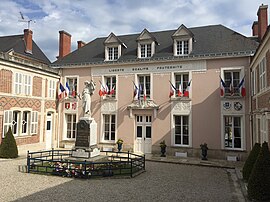Hautvillers
Hautvillers | |
|---|---|
 The town hall in Hautvillers | |
| Coordinates: 49°05′06″N 3°56′40″E / 49.085°N 3.9444°E | |
| Country | France |
| Region | Grand Est |
| Department | Marne |
| Arrondissement | Épernay |
| Canton | Épernay-1 |
| Intercommunality | Grande Vallée de la Marne |
| Government | |
| • Mayor (2020–2026) | Silvère Pierrot[1] |
| Area 1 | 11.77 km2 (4.54 sq mi) |
| Population (2021)[2] | 649 |
| • Density | 55/km2 (140/sq mi) |
| Time zone | UTC+01:00 (CET) |
| • Summer (DST) | UTC+02:00 (CEST) |
| INSEE/Postal code | 51287 /51160 |
| 1 French Land Register data, which excludes lakes, ponds, glaciers > 1 km2 (0.386 sq mi or 247 acres) and river estuaries. | |
Hautvillers (French pronunciation: [ovile]) is a commune in the Marne department in north-eastern France.
The Abbey of St. Peter which existed here until the French Revolution was the home of the famous Dom Perignon, a Benedictine monk whose work in wine-making helped to develop champagne. Because of the region's testimony to the development of champagne and unique agro-industrial system, the nearby vineyards, harvest huts, presses, and cellars were inscribed on the UNESCO World Heritage List in 2015 as part of the Champagne hillsides, houses and cellars site.[3] The underground cellars, used for storing and fermenting the champagne, were built in the late 17th century and are some of the first cellars specifically dedicated to storing champagne.[3]

See also[edit]
References[edit]
- ^ "Répertoire national des élus: les maires" (in French). data.gouv.fr, Plateforme ouverte des données publiques françaises. 13 September 2022.
- ^ "Populations légales 2021". The National Institute of Statistics and Economic Studies. 28 December 2023.
- ^ a b "Champagne Hillsides, Houses and Cellars". UNESCO World Heritage Centre. United Nations Educational, Scientific, and Cultural Organization. Retrieved 12 December 2021.




